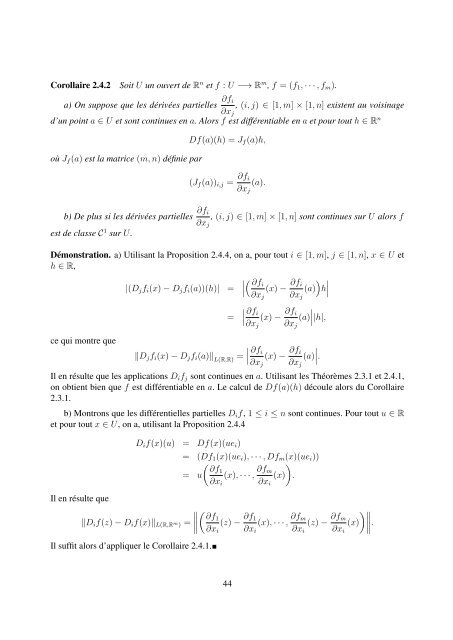LICENCE DE MATHÉMATIQUES FONDAMENTALES Calcul ...
LICENCE DE MATHÉMATIQUES FONDAMENTALES Calcul ...
LICENCE DE MATHÉMATIQUES FONDAMENTALES Calcul ...
You also want an ePaper? Increase the reach of your titles
YUMPU automatically turns print PDFs into web optimized ePapers that Google loves.
Corollaire 2.4.2 Soit U un ouvert de R n et f : U −→ R m , f = (f 1 , · · · , f m ).<br />
a) On suppose que les dérivées partielles ∂f i<br />
∂x j<br />
, (i, j) ∈ [1, m] × [1, n] existent au voisinage<br />
d’un point a ∈ U et sont continues en a. Alors f est différentiable en a et pour tout h ∈ R n<br />
où J f (a) est la matrice (m, n) définie par<br />
Df(a)(h) = J f (a)h,<br />
(J f (a)) i,j = ∂f i<br />
∂x j<br />
(a).<br />
b) De plus si les dérivées partielles ∂f i<br />
∂x j<br />
, (i, j) ∈ [1, m] × [1, n] sont continues sur U alors f<br />
est de classe C 1 sur U.<br />
Démonstration. a) Utilisant la Proposition 2.4.4, on a, pour tout i ∈ [1, m], j ∈ [1, n], x ∈ U et<br />
h ∈ R,<br />
( ∂fi<br />
|(D j f i (x) − D j f i (a))(h)| = ∣ (x) − ∂f )<br />
i<br />
(a) h∣<br />
∂x j ∂x j<br />
ce qui montre que<br />
=<br />
∣ ∂f i<br />
(x) − ∂f i ∣<br />
(a) ∣|h|,<br />
∂x j ∂x j<br />
‖D j f i (x) − D j f i (a)‖ L(R,R)<br />
= ∣ ∂f i<br />
(x) − ∂f i ∣<br />
(a) ∣.<br />
∂x j ∂x j<br />
Il en résulte que les applications D i f j sont continues en a. Utilisant les Théorèmes 2.3.1 et 2.4.1,<br />
on obtient bien que f est différentiable en a. Le calcul de Df(a)(h) découle alors du Corollaire<br />
2.3.1.<br />
b) Montrons que les différentielles partielles D i f, 1 ≤ i ≤ n sont continues. Pour tout u ∈ R<br />
et pour tout x ∈ U, on a, utilisant la Proposition 2.4.4<br />
D i f(x)(u) = Df(x)(ue i )<br />
= (Df 1 (x)(ue i ), · · · , Df m (x)(ue i ))<br />
( ∂f1<br />
= u (x), · · · , ∂f )<br />
m<br />
(x) .<br />
∂x i ∂x i<br />
Il en résulte que<br />
( ‖D i f(z) − D i f(x)‖ L(R,R m ) =<br />
∂f1<br />
∥ (z) − ∂f 1<br />
(x), · · · , ∂f m<br />
(z) − ∂f )∥<br />
m ∥∥∥<br />
(x) .<br />
∂x i ∂x i ∂x i ∂x i<br />
Il suffit alors d’appliquer le Corollaire 2.4.1.<br />
44

















